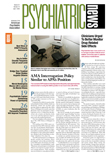State emergency officials say that to cope better with the health issues resulting from future disasters, they need more training before catastrophes occur, better coordination with other state and regional bodies, and improved communication with U.S. government agencies.
Their views coalesced at a three-day meeting convened in May by the Substance Abuse and Mental Health Services Administration (SAMHSA) to discuss lessons for the mental health community from hurricanes katrina, Rita, and Wilma. Talks at the New Orleans meeting and discussions with participants made it clear that the burden of mental health readiness for future natural or manmade disasters will fall to cities, counties, and states. Further regional coordination with surrounding jurisdictions will be needed, too, as katrina made clear last fall.
However, an infusion of new funding is unlikely to come from the federal government. SAMHSA officials said they can offer localities only technical assistance, but only Congress can authorize new funding.
“Planning starts on the state and local levels,” said A. kathryn Power, M.Ed., director of SAMHSA's Center for Mental Health Services.“ Don't rely solely on the feds.”
To rely more on themselves, representatives of states and localities agreed that they must begin with explicit plans to cope with large-scale emergencies and must hold training exercises to drill public employees and volunteers in their execution.
“Identify the role of your organization in times of disaster, know those roles, and train for those roles,” Michael Duffy, R.N., assistant director of the Office of Addictive Disorders in the Louisiana Department of Health and Hospitals, told the group.
“It helps to have a permanent crisis-response committee [for mental health] to set up and coordinate response around the state,” added Jeff Bennett, L.C.S.W., director of the Gulf Coast Mental Health Center in Gulfport, Miss.
Last year's hurricanes taught mental health and substance abuse officials who felt the storms' impact the need for thinking across jurisdictional lines and beyond the usual short-term needs of storm victims. Agencies have to form links with emergency management bodies well before disasters strike and practice with the general disaster response team. Summed up one official:“ Think horizontally.”
For instance, Mississippi is planning to establish a permanent cross-agency group covering its emergency management agency; the state health department; local agencies at state, regional, local levels; and governments, volunteer organizations, and professional organizations.
Planning requires not just documents, but face-to-face contact among personnel in advance of events, said participants. Setting up protocols with nonprofit groups or religious organizations to establish a role for volunteers can help. North Carolina has agreements in place to send groups of volunteers anywhere in the state they are needed.
Planners must think beyond maps and organization charts, though.
“We tend to organize plans around a command and control structure, not around human behavior,” added Dave Wanser, Ph.D., deputy commissioner for behavioral and community health in the Texas Department of State Health Services. “For instance, before Hurricane Rita we ordered an evacuation, and everybody left at once, jamming the roads. Planning needs to accommodate how people really act in disasters. Plan for people who will come to you and also for those you have to go to.”
Katrina made clear the need for regional coordination, too, as storm and flood victims were evacuated to neighboring states.
Merely keeping track of hundreds of thousands of people on the move was difficult. Telephoning shelters for head counts might give wildly different numbers in a matter of a few hours. New Orleans residents camped out in a state park in Tennessee but were “lost” when they moved on without informing anyone. Alabama also sheltered many evacuees in state parks, but the evacuees were often in remote areas, away from bus lines, and didn't have easy access to services or to Federal Emergency Management (FEMA) offices.“ Next time, we'll put them in parks nearer to towns,” said an Alabama official.
Special populations demanded closer attention as well. Children were a special focus of psychiatrists and others after the storms (see story at left), but the seriously ill were subject to conflicting policies, sometimes left behind during evacuations.
“The federal view is to move the well populations, who have mostly transient distress, but not to move fragile people,” said one participant. “We need to drop barriers to sheltering them.”
Paying for behavioral health services also occupied participants. Many complained that the current emergency grant process was slow and cumbersome. Managing complex funding streams from multiple sources was further complicated by different accounting and reporting standards from various government departments.
“Expedite the hoops, procedures, and paperwork,” said one.“ Simplify the application process and provide help in applying. We don't have a dedicated mental health disaster person to handle it.”
Others complained of the gap between short-term emergency funding and longer-term recovery funding that leaves both victims and service providers in limbo for weeks or months. Funding should also follow evacuees, so that a family sheltered and registered in a state other than their own would have access to care there.
Communication is critical both before and during emergencies. Technically, backups are needed for backups. After katrina, land lines and cell phones were knocked out when power was lost to relay towers. Even satellite phones went out because batteries couldn't be recharged. But communication involves more than technology.
“You need an incident command structure not to command but to communicate,” said ken DeCerchio, M.S.W., C.A.P., assistant secretary for substance abuse and mental health in the Florida Department of Children and Families.
More opportunities for face-to-face sharing of information in advance and ways to report relocation information across state lines during emergencies are needed, possibly using a central, easily accessible database for needs assessment, shelter occupancy, hotel use, and hospital capacity. Several attendees recalled getting different answers to the same questions, depending on when they called and who picked up the phone at FEMA. Words count, too. Even familiar terms like “treatment” may mean different things to different agencies, so development of a vocabulary common to all parties would enhance communication and speed help to disaster victims.
“There's a need for consistent, accurate information during the process of a disaster,” said Duffy. “This helps the staff as well as the public.”
Clinically, the conventional approach to postdisaster health care also needs revision, added Wanser. He decried a tendency among shelter directors to recommend immediate removal and hospitalization of individuals who were distraught.
Federal stockpiles of pharmaceuticals should include psychotropic drugs, which were not in the formulary last September, said Duffy.
Substance abuse requires more attention across the board, as both existing abusers seek help and stressed individuals start or increase use. Specialized professional experience is useful as well.
“Suppose a person is visiting doctors on each shift asking for pain medications,” Wanser said. “Public health people don't realize this is a problem, but people who work in substance abuse treatment do.”
Conference participants also argued for simplifying ways to allow outside health care professionals into states for short periods during disasters.
“Why not set up a national registry to solve credentialing and malpractice insurance problems?” said William R. Breakey, M.D., emeritus professor of psychiatry at Johns Hopkins. “Helping out after a disaster is an exciting, eye-opening learning opportunity that expands your range of skills and experiences.”
Physicians and other health professionals who volunteered for the SAMHSA-coordinated program in effect after katrina and Rita usually served for two weeks. One veteran of that experience said that the investment in learning time would give a greater payoff if deployments were longer (that is, three weeks) or a split four-week commitment. More money should be allocated for advanced training and smoother transitions to following teams or to the local health care system.
At every level, after the acute response to disasters or after disaster training, recording what worked and what did not is essential, said Florida's DeCerchio. “you have to do after-action briefings to be ready for the next season and create documentation to help the person who comes behind you.”
Finally, said one participant at the end of the meeting, federal agencies should start thinking about an “all-hazards” approach to disaster. Homeland security funding has been too narrowly focused on antiterrorism efforts and not at all on the consequences of earthquakes, hurricanes, and other natural disasters. If disaster knows no geographic borders, he implied, neither is it bound by the source of the catastrophe.
Presentations from SAMHSA's “Spirit of Recovery Summit” are posted at<www.spiritofrecoverysummit.com/presentations.htm>.▪

